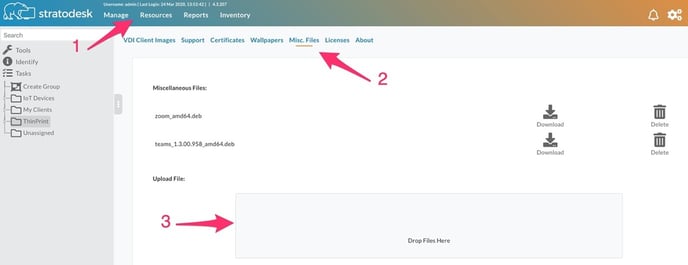NoTouch supports common Unified Communications platforms locally and redirected from VDI, Daas, and CloudPC
Collaboration Plug-ins - MS Teams \ Zoom
NoTouch Center currently supports integration of Microsoft Teams and Zoom. For more information on configuration and set up see the blog posted Here
Microsoft Teams & Zoom Integration into NoTouch Desktop
Did you know that you can install Microsoft Teams & Zoom directly onto NoTouch Desktop? Well the answer is a clear yes! As more and more companies are allowing users to work from home due to a pandemic or other issue that may keep workers away from an office, one of the main consideration points is collaboration.
Microsoft Teams
If you are currently using Skype for Business in Citrix XenApp/XenDesktop or VMware Horizon environment, then there are tools like the Realtime Media Engine (Citrix) or the Virtualization Pack for Skype for Business (VMware) that will optimise audio and video directly between endpoints for one to one collaboration or online meetings, and we already support this feature.
However, Microsoft has been pushing organisations towards the use of Microsoft Teams and is the default tool for their Office365 package. The current downside to this is that if you are connecting to your VDI environment from a Linux endpoint then there are no optimisation tools available from Citrix & VMware, although Citrix can optimise using the Windows version of the Workspace App.
In January this year and upon the release of the Microsoft Teams client for Linux Stratodesk created a mechanism of installing this directly onto NoTouch Desktop and can be done using a few simple steps.
Firstly, download the Debian file directly from Microsoft, and this is likely to be in the following format: teams_1.3.00.958_amd64.deb
Then log into NoTouch Center, and under Resources-Misc.Files upload the Debian file, and a screen shot is shown below for reference.

If you are using the self-signed certificate for NoTouch Centre, then we need to disable a setting so the files will download, so go to ‘Security’ in ‘Group Settings’ and ensure the parameter ‘Check Certificate at System Downloads’ is turned off.

Now that you have uploaded to NoTouch Center you need to push the installation to the NoTouch Desktop Endpoints, and we do this using the ‘Extensions’ option in ‘Group Settings’ as shown below.

You have the option entering a url, so you can use method shown or you could upload to your own webserver for distribution. If you're using Microsoft's IIS to serve the install files, please make sure that you've selected "application/octet-stream" for the MIME type *.deb otherwise the downloads will not work.
Another option is to use the ‘Choose File’ option and select the correct file from the dropdown list. Once you have announced the changes a reboot will be required for the installation to work.
Finally, create your connection for Microsoft Teams from NoTouch Center and announce the change to the endpoints for the connection to appear on the desktop.
During our tests any notifications for things like chat & audio video calls from Microsoft Teams appeared in our virtual desktop session, and we were able to respond to these. If there is one negative to this and there is one, if you need to initiate chat or audio video call then you must do this from the NoTouch Desktop. However, we hope that this a compromise worth accepting in the current climate and hopefully both Citrix & VMware will release the new optimization tools very soon.
Zoom Video Conferencing (Citrix Plugin)
NoTouch Desktop also supports Zoom video conferencing solution, which is also illustrated above, and we also support the installation of the Zoom Citrix Plugin. If you wish to create a Zoom connection for the local desktop then you must do this from NoTouch Center using the usual method, and select Zoom for the 'connection mode'. No Other Configuration is required.

We tested using the following, and results may differ based on the hardware being used.
Stratodesk NoTouch OS 3.1.428 EEs (x86 builds only) HP t530 Thin Client Microsoft LifeCam HD3000 Logitech H600 Wireless Headset
